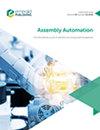在操作过程中,平滑地适应粘度和速度
IF 1.7
4区 计算机科学
Q3 AUTOMATION & CONTROL SYSTEMS
引用次数: 0
摘要
目的当机器人与人类用户共同操作物体时,阻尼是一种有用的功能。这是通过对机器人进行编程以显示粘性场来实现的。对于某些特定的应用,粘度需要根据操作速度而变化。一种已报道的方法是编程粘度与速度成反比变化。在本文中,实验表明这种方法会扭曲人类的自然运动性能。本文旨在提出一种解决这一不稳定性问题的方法。设计/方法/方法作者进行了点对点靶向运动,观察到不稳定性是由于机器人运动阻力突然降低造成的,这进一步是由于受试者试图加速时粘度突然下降造成的。因此,作者提出了一种解决方案,在粘度系数中加入一阶线性滤波器,以减缓其变化。实验结果证实,该命题是有效的,具有稳定可操作动力学和恢复人类自然行为的能力。独创性/价值本文涉及共操作的应用,其中粘度系数被设计为随着速度的增加而减小。通过人机实验对一个在安全性和性能方面至关重要但文献中未报道的不稳定性问题进行了实验研究。通过在粘度变化中加入二次动力学,提出了一种解决方案。它的有效性得到了实际点对点运动实验的支持。本文章由计算机程序翻译,如有差异,请以英文原文为准。
Smoothly adapting viscosity to velocity during comanipulation pointing movements
Purpose
When a robot comanipulates an object with a human user, damping is a useful function. This is achieved by programming the robot to exhibit a viscous field. For some specific applications, the viscosity is required to change according to the manipulation velocity. A reported method is programming the viscosity varying inversely to the velocity. In this paper, this method is experimentally shown to distort human’s natural motion performance. This paper aims to propose a solution to solve this instability problem.
Design/methodology/approach
The authors performed a point-to-point targeting movement, where it was observed that the instability results from a sudden reduction of robot’s resistance to motion, which further results from the abrupt viscosity drop when the subject tries to accelerate. Therefore, the authors propose a solution where a first-order linear filter is added to the viscosity coefficient so as to slow down its variation.
Findings
The experimental results confirm that the proposition is effective, with the ability to stabilize the comanipulated dynamics and to restore the human’s natural behavior.
Originality/value
This paper concerns applications of comanipulation where the viscosity coefficient is designed to decrease as the velocity increases. An instability problem, which was of vital importance in terms of safety and performance but unreported in the literature, was experimentally studied through human–robot experiments. A solution was proposed by including a secondary dynamics in the variations of the viscosity. Its effectiveness was supported by the practical point-to-point motion experiments.
求助全文
通过发布文献求助,成功后即可免费获取论文全文。
去求助
来源期刊

Assembly Automation
工程技术-工程:制造
CiteScore
4.30
自引率
14.30%
发文量
51
审稿时长
3.3 months
期刊介绍:
Assembly Automation publishes peer reviewed research articles, technology reviews and specially commissioned case studies. Each issue includes high quality content covering all aspects of assembly technology and automation, and reflecting the most interesting and strategically important research and development activities from around the world. Because of this, readers can stay at the very forefront of industry developments.
All research articles undergo rigorous double-blind peer review, and the journal’s policy of not publishing work that has only been tested in simulation means that only the very best and most practical research articles are included. This ensures that the material that is published has real relevance and value for commercial manufacturing and research organizations.
 求助内容:
求助内容: 应助结果提醒方式:
应助结果提醒方式:


